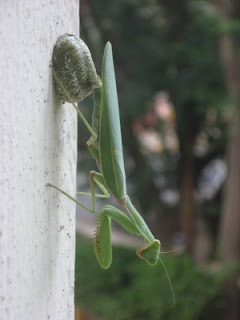Latin Name: Order Mantodea. (15 families and over 2,200 species in the world.)
Why are they beneficial?
Adults and nymphs are ferocious general predators.
They eat all insects (and sometimes small lizards, frogs, birds, snakes, fish, and rodents!).
Unfortunately, they will eat other beneficial insects, too, but their usefulness outweighs this drawback.
What is their life cycle?
The male will mate with a female in Autumn, and about 15% of the time the female will engage in “sexual cannabalism”… yeah, she will eat her mate, usually starting with the head.
The female will lay her eggs (containing from 10-400 eggs) in a frothy mass that hardens into an egg case called an ootheca.
The egg case is typically attached to a flat surface (like a wall) or around a plant stem or sometimes directly on the ground.
When temperatures begin to warm up in spring time, the egg case will hatch.
The newly hatched nymphs look almost identical to the adults, but they are smaller, cannot fly, and are sexually immature.
Within about 6 months, after several moltings, the adult mantis arrives.
What do they look like?
These guys are pretty easy to spot, but I will show you the egg case (ootheca) and the nymphs as well.
What do they need?
Praying Mantises feed exclusively on insects (and occasionally other small animals as well). Most species are ambush predators, but some will chase their prey. Adults die at the end of the season. Only the egg case will survive until the next spring; it is very winter hardy. There is very little a person needs to do to attract/keep these insects around other than avoiding chemicals that will poison them directly or indirectly through their food. You can always purchase egg cases to set out in your garden as well.


















